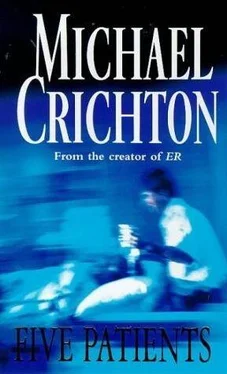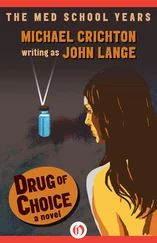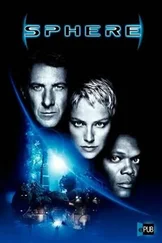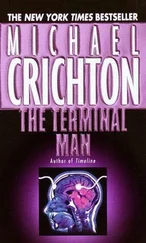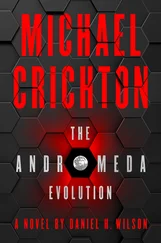Michael Crichton - Five Patients
Здесь есть возможность читать онлайн «Michael Crichton - Five Patients» весь текст электронной книги совершенно бесплатно (целиком полную версию без сокращений). В некоторых случаях можно слушать аудио, скачать через торрент в формате fb2 и присутствует краткое содержание. Жанр: Триллер, на английском языке. Описание произведения, (предисловие) а так же отзывы посетителей доступны на портале библиотеки ЛибКат.
- Название:Five Patients
- Автор:
- Жанр:
- Год:неизвестен
- ISBN:нет данных
- Рейтинг книги:5 / 5. Голосов: 1
-
Избранное:Добавить в избранное
- Отзывы:
-
Ваша оценка:
- 100
- 1
- 2
- 3
- 4
- 5
Five Patients: краткое содержание, описание и аннотация
Предлагаем к чтению аннотацию, описание, краткое содержание или предисловие (зависит от того, что написал сам автор книги «Five Patients»). Если вы не нашли необходимую информацию о книге — напишите в комментариях, мы постараемся отыскать её.
Five Patients — читать онлайн бесплатно полную книгу (весь текст) целиком
Ниже представлен текст книги, разбитый по страницам. Система сохранения места последней прочитанной страницы, позволяет с удобством читать онлайн бесплатно книгу «Five Patients», без необходимости каждый раз заново искать на чём Вы остановились. Поставьте закладку, и сможете в любой момент перейти на страницу, на которой закончили чтение.
Интервал:
Закладка:
In the future, it may be possible to have a computer monitor the patient and carry out therapy, maintaining the patient within certain limits established by physicians-or even by the computer itself.
The major consequence, indeed the avowed aim, of computer therapy in any form will be to reduce the routine work of patient care done by doctors. Other elements of that care are already disappearing; nurses have taken over several of these, and technicians have taken over others. Thus, during the week, the MGH has routine blood samples drawn by technicians and routine intravenous maintenance-starting IV lines and keeping them running-done by specially trained IV nurses. These programs were quite radical a few years ago, when doctors thought nurses constitutionally incapable of dealing with intravenous lines or drawing blood from a vein. But a startling consequence of this new specialization of nonphysician health personnel has been better care, in certain areas, than the physician himself could deliver. Even if doctors don't believe this, the patients know it well. On weekends, when the IV nurses and the blood technicians are off duty, the patients complain bitterly that the physicians are not as skilled in these tasks.
As for the special skills still reserved to physicians, such as lumbar punctures and thoracic and abdominal taps, it is only a matter of time before someone discovers that these, too, can be effectively delegated to other personnel.
It would thus appear that all the functions of a doctor are being taken over either by other people or by machines. What will be left to the doctor of the future?
Almost certainly he will begin to move in one of two directions. The first is clearly toward full-time research. The last fifteen years have seen a striking increase in the number of hospital-based physicians and the number of doctors conducting research in governmental agencies. This trend will almost surely continue.
A second direction will be away from science toward the "art" of medicine-the complex, very human problems of helping people adjust to disease processes; for there will always be a gap between the illnesses medicine faces and science's limitations in treating them. And there will always be a need for people to bridge that gap.
Physicians moving in either direction will be helped by a new freedom from the details of patient care; and physicians now emotionally attached to those details, such as those doctors who religiously insist on doing their own lab work, are mistaking the nature of their trade. Almost invariably, they would do better spending their time talking with the patient, and letting somebody else look at the blood and urine or count the cells in the spinal fluid-especially if that person (or machine) can work more rapidly and accurately than the physician himself.
One can argue that this presages a split among physicians, between those with a scientific, research orientation, and those with a behavioral, almost psychiatric, orientation. That split has already begun and some bemoan it. But, in reality, art and science have rarely merged well in a single individual. It is said that Einstein would have starved as a cellist, and it is certainly true that the number of doctors in recent years who have been both superb clinicians and excellent laboratory researchers is really quite small. Such men certainly can be found, and they are always impressive-but they are distinctly in the minority. In fact, the modern notion that the average physician is a practitioner of both art and science is at best a charming myth, at worst a serious occupational delusion.
In the final analysis, what does all this mean for the hospital and for the patient in the hospital? One may look at the short-term possibilities, as represented by the burns treatment program.
It will reduce the mundane work of ward personnel, both doctors and nurses, and leave them more time to spend with the patient. For doctors, it should mean more time for research as well. And for the patient, that should ultimately be a good thing.
Furthermore, as an extension of the hospital, a computer program offers quite extraordinary possibilities. Any hospital in the country-or even any doctor's office-could utilize the program, by using existing telephone lines. A community hospital could plug into the MGH program and let the computer monitor the patient and direct therapy. As a way to utilize the innovative capability of the hospital, and its vast resources of complex medical information, this must surely represent a logical step in 2,500 years of evolution. And for the patient, that, too, should ultimately be a good thing.
Edith Murphy. Patient and Doctor
Six months before she came to the MGH, Mrs. Murphy, a fifty-five-year-old mother of three, began to notice swelling of her legs and ankles. This swelling increased and she became progressively weaker, until finally she had to quit her job as a filing clerk. She consulted her local doctor, who prescribed digitalis and diuretics. This reduced the swelling but did not eliminate it completely. She continued to feel very weak.
Finally she was admitted to a local community hospital where she was found to be severely anemic, to have bleeding in her gastrointestinal tract, to have chemical evidence of liver disease, and X rays suggestive of cancer of the pancreas. At this point, she was transferred to the MGH. She knew nothing of her suspected diagnosis.
On arrival she was seen by Edmund Carey, a medical student, and Dr. A. W. Nienhuis, a house officer. They found that she was slightly jaundiced and that her abdomen was distended with fluid. Her liver could not be felt because of this fluid. Her legs and ankles were still swollen. They confirmed the presence of blood in her stools.
Laboratory studies indicated a hematocrit of 18 per cent, which meant that she had less than half the normal number of red blood cells. Her reticu-locyte count, a measure of new-blood-cell production, was increased. A measurement of iron in her blood showed that she was iron-deficient. The total picture was thus consistent with chronic anemia from blood loss through the gastrointestinal tract, [The technical reader must excuse some simplification in this presentation] but the situation was more complex: A Coombs blood test was positive, suggesting that her body was also destroying red cells by an allergic mechanism.
A chest X ray and electrocardiogram and kidney studies were normal. Barium X-ray studies of the upper GI tract, to check the suggestion of pancreatic cancer, could not be done immediately. A bone-marrow biopsy was done, but it gave no further clue to the nature of the anemia. Her abdomen was tapped and a sample of fluid withdrawn for analysis. There was laboratory evidence to suggest liver disease and perhaps insufficient proteins in her blood, but this could not be immediately confirmed on the night of admission.
Mrs. Murphy thus presented a complex and puzzling problem. The first question was whether a single disease process could explain her three major difficulties, which Dr. Nienhuis summarized as anemia, gastrointestinal disease, and edema. As he noted, they could all be explained, in whole or in part, by cancer or liver disease, by invoking mechanisms that are quite complicated.
Implicit in his thinking was the notion that the body is constantly changing, and that those features of the body which appear static are really the product of a dynamic equilibrium. Thus the red-cell volume of the body, which usually appears fairly constant, is really the product of ceaseless creation and destruction of cells. The average red cell has a life span of 120 days; anemia can result from either inadequate production of cells or excessive destruction of cells. In Mrs. Murphy's case, production seemed actually increased, but she was losing cells through bleeding and allergic destruction.
Читать дальшеИнтервал:
Закладка:
Похожие книги на «Five Patients»
Представляем Вашему вниманию похожие книги на «Five Patients» списком для выбора. Мы отобрали схожую по названию и смыслу литературу в надежде предоставить читателям больше вариантов отыскать новые, интересные, ещё непрочитанные произведения.
Обсуждение, отзывы о книге «Five Patients» и просто собственные мнения читателей. Оставьте ваши комментарии, напишите, что Вы думаете о произведении, его смысле или главных героях. Укажите что конкретно понравилось, а что нет, и почему Вы так считаете.
